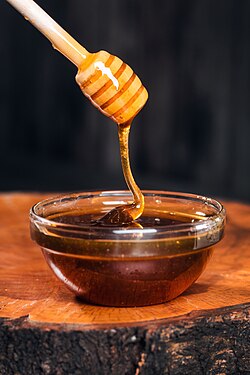Pine honey Source: en.wikipedia.org/wiki/Pine_honey

Pine honey (Greek: πευκόμελο, romanized: pefkomelo; Turkish: çam balı) is a type of honeydew honey.[1] It is a sweet and spicy honey, with some woody notes, a resinous fragrance and dark amber color. It is a common breakfast dish in Turkey and Greece, where it is drizzled over yoghurt and eaten with bread.[1]
Pine honey is an unusual honey, because it is not produced entirely by honey bees.[2] It is produced by bees that collect honeydew (sugary secretions) from a scale insect species called Marchalina hellenica, which lives on the sap of certain pine trees.[3] The M. hellenica can be found on the Turkish Pine (Pinus brutia), as well as the Aleppo Pine (P. halepensis), Austrian Pine (P. nigra), Scots Pine (P. sylvestris), and Stone Pine (P. pinea).[4][5]
Pine honey is commonly produced anywhere pine forests are plentiful and conventional honey sources, such as flowers or fruit tree blossoms, are few. It can be found in some heavily forested areas of Germany, Norway, Italy,[6] New Zealand, and the United States but is primarily produced in the pine forests of the eastern Mediterranean.[3][7][8] Major production occurs in Turkey, the Middle East, the Balkans, and many Greek mountains and islands. The monastic communities at Mount Athos in Greece are renowned for their pine honey production and throughout Greece pine honey makes up 60–65% of total honey production.[9] Turkey produces 92% of the world’s pine honey.[10][11] Muğla Province accounts for 80% of Turkish pine honey production.[12]
References
[edit]- ^ a b Marchese, C. Marina (2011-05-20). Honeybee: Lessons from an Accidental Beekeeper. Running Press. ISBN 978-1-60376-239-7.
- ^ Toussaint-Samat, Maguelonne (2009-03-25). A History of Food. John Wiley & Sons. ISBN 978-1-4443-0514-2.
- ^ a b de-Miguel, Sergio; Pukkala, Timo; Yeşil, Ahmet (2014-05-01). "Integrating pine honeydew honey production into forest management optimization". European Journal of Forest Research. 133 (3): 423–432. doi:10.1007/s10342-013-0774-2. S2CID 12647284.
- ^ Crane, Ethel Eva (2013-08-16). The World History of Beekeeping and Honey Hunting. Routledge. ISBN 978-1-136-74669-7.
- ^ Paine, Timothy D.; Lieutier, Francois (2016-01-06). Insects and Diseases of Mediterranean Forest Systems. Springer. ISBN 978-3-319-24744-1.
- ^ "Il miele di melata". www.bioapi.it. Archived from the original on 25 April 2016. Retrieved 12 January 2022.
- ^ "All About German Honey - Germanfoods.org". Retrieved 2021-08-07.
- ^ "Honeydew – Forest Honeys". Honey Traveler. Retrieved 2021-08-07.
- ^ Gounari, S (2006-03-01). "Studies on the phenology of Marchalina hellenica (Gen.) (Hemiptera: Coccoidea, Margarodidae) in relation to honeydew flow". Journal of Apicultural Research: 8–12. doi:10.3896/IBRA.1.45.1.03.
- ^ "Turkey makes over 90 percent of pine honey production worldwide". DailySabah. 27 November 2015. Retrieved 2018-04-03.
- ^ The Turkish Bee Keeping and Honey Sector, United States Department of Agriculture, 2015
- ^ "Muğla'da çam balı üretimi yüze 50 düştü". Dünya Gazetesi. 2016-01-06. Retrieved 2018-04-03.